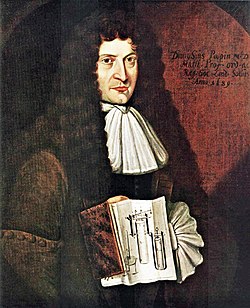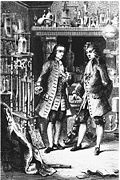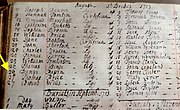| This article needs additional citations for verification. Please help improve this article by adding citations to reliable sources. Unsourced material may be challenged and removed. Find sources: "Denis Papin" – news · newspapers · books · scholar · JSTOR (May 2014) (Learn how and when to remove this message) |
| Denis Papin | |
|---|---|
 Denis Papin, unknown artist, 1689 Denis Papin, unknown artist, 1689 | |
| Born | (1647-08-22)22 August 1647 Chitenay, now Loir-et-Cher, France |
| Died | 26 August 1713(1713-08-26) (aged 66) London, Great Britain |
| Nationality | French |
| Education | University of Angers |
| Known for | Steam digester |
| Scientific career | |
| Institutions | University of Marburg |
Denis Papin FRS (French pronunciation: [dəni papɛ̃]; 22 August 1647 – 26 August 1713) was a French physicist, mathematician and inventor, best known for his pioneering invention of the steam digester, the forerunner of the pressure cooker, the steam engine, the centrifugal pump, submersible and possibly the paddlesteamer (1707).
Early life and education
Born in Chitenay (Loir-et-Cher, Centre-Val de Loire Région), Papin attended a Jesuit school there. In 1661, he attended the University of Angers, from which he graduated with a medical degree in 1669.
Career
In 1673, Papin worked with Christiaan Huygens and Gottfried Leibniz in Paris, and became interested in using a vacuum to generate motive power.
In 1675, he first visited London, where he worked with Robert Boyle from 1676 to 1679, publishing an account of his work in Continuation of New Experiments (1680). During this period, Papin invented the steam digester, a type of pressure cooker with a safety valve. He first addressed the Royal Society in 1679 on the subject of his digester, and remained mostly in London. As a Huguenot, Papin found himself greatly affected by the increasing restrictions placed on Protestants by Louis XIV of France and by the King's ultimate revocation of the Edict of Nantes in 1685.
In Germany, he was able to live with fellow Huguenot exiles from France, so in about 1687, he left to take up an academic post in Germany.
In 1689, Papin suggested that a force pump or bellows could maintain the pressure and fresh air inside a diving bell. (Engineer John Smeaton utilised this design in 1789.)
While in Marburg in 1690, having observed the mechanical power of atmospheric pressure on his 'digester', Papin built a model of a piston steam engine, the first of its kind. In 1705 while teaching mathematics at the University of Marburg, he developed a second steam engine with the help of Gottfried Leibniz, based on an invention by Thomas Savery, but this used steam pressure rather than atmospheric pressure. Details of the engine were published in 1707.
In 1705, Papin constructed a ship powered by hand-cranked paddles. An apocryphal story originating in 1851 by Louis Figuire held that this ship was steam-powered rather than hand-powered and that it was therefore the first steam-powered vehicle of any kind. The myth was refuted as early as 1880 by Ernst Gerland [de], though still it finds credulous expression in some contemporary scholarly work.
Papin's ship was said to have been destroyed in 1707 by the boatmen of Munden who feared it would threaten their livelihood. The scene of boatmen destroying Papin's ship is depicted in several pieces of art in the eighteenth century and serves as an example of the resistance and fear inspired by the creative destruction that accompanies new technology.
Later, at the iron foundry in Veckerhagen (now Reinhardshagen), he cast the world's first steam cylinder.
In 1707, Papin returned to London leaving his wife in Germany. Several of his papers were put before the Royal Society between 1707 and 1712 without acknowledging or paying him, about which he complained bitterly. Papin's ideas included a description of his 1690 atmospheric steam engine, similar to that built and put into use by Thomas Newcomen in 1712, thought to be the year of Papin's death.
-
 Robert Boyle and Denis Papin inspecting Papin's digester
Robert Boyle and Denis Papin inspecting Papin's digester
-
 Denis Papin's steam digester (1679)
Denis Papin's steam digester (1679)
-
 Papin's first piston steam pump, 1690
Papin's first piston steam pump, 1690
-
 Papin's second steam pump, 1706/07
Papin's second steam pump, 1706/07
-
 Papin's second steam pump driving a water wheel (on the left), 1706/07
Papin's second steam pump driving a water wheel (on the left), 1706/07
-
 Steam-driven water-lifting machine by Papin in 1707, reconstruction, from Nouvelle manière d'élever l'eau par la force du feu. Musée des Arts et Métiers
Steam-driven water-lifting machine by Papin in 1707, reconstruction, from Nouvelle manière d'élever l'eau par la force du feu. Musée des Arts et Métiers
-
 The Register from St Bride's Church showing the date of Papin's burial
The Register from St Bride's Church showing the date of Papin's burial
-
 A "Papin" cooking pot, late 18th century
A "Papin" cooking pot, late 18th century
-
 Papin's Memorial in St Bride's Church
Papin's Memorial in St Bride's Church
Death
The last surviving evidence of Papin's whereabouts came in a letter he wrote dated 23 January 1712. At the time he was destitute ("I am in a sad case") , and it was believed that he died that year and was buried in an unmarked grave in London.
However, a record exists for the burial of a “Denys Papin” in an 18th-century Register of Marriages & Burials which originally came from St Bride's Church, Fleet Street, London, but which is stored in the London Metropolitan Archives. The record states that Denys Papin was buried at St Bride's on 26 August 1713 – just a few days after his 66th birthday – and that he was buried in the Lower Ground, one of the two burial areas belonging to the church at the time. Since the discovery, in 2016, of the place and date of Papin's burial in 1713, a memorial plaque has been erected in the West Entrance of St Bride's Church, Fleet Street, London, to commemorate his life and his achievements.
Legacy
Boulevard Denis Papin in Carcassonne is named after him as well as a street in Saint-Michel, Montreal. There is also a statue of Papin with his invention in Blois, at the top of the Escalier Denis Papin, a stairway.

Works
- Nouvelle manière pour lever l'eau par la force du feu ... par m. D. Papin. A Cassel: pour Jacob Estienne libraire de la cour : par Jean Gaspard Voguel imprimeur. 1707.
References
- Excerpt from St Bride's Register Marriages Burrials
- Hindle, Brooke; Lubar, Steven (1986). Engines of Change: The American Industrial Revolution 1790-1860. Washington, DC and London: Smithsonian Institution Press. ISBN 0-87474-540-3.
- Acta Eruditorum. Leipzig. 1689. p. 96.
- Alonso Péan, Louis de La Saussaye: La vie et les ouvrages de Denis Papin. Franck, Paris 1869, S. 235 ff. (gallica.bnf.fr).
- Capitel 14. Actenmäßiger Beweis, daß das erste Dampfschiff der Welt auf der Fulda von Cassel nach Münden gefahren und daselbst vernichtet wurde. In: Geschichte der Stadt Münden. Münden 1878, S. 113 ff. (Digitalisat).
- Anita McConnell, 'Papin, Denis (1647–1712?)', Oxford Dictionary of National Biography, Oxford University Press, 2004, accessed 29 April 2006]
- Davis, RH (1955). Deep Diving and Submarine Operations (6th ed.). Tolworth, Surbiton, Surrey: Siebe Gorman & Company Ltd. p. 693.
- Acott, C. (1999). "A brief history of diving and decompression illness". South Pacific Underwater Medicine Society Journal. 29 (2). ISSN 0813-1988. OCLC 16986801. Archived from the original on 27 June 2008. Retrieved 17 March 2009.
- Daron Acemoğlu; James A. Robinson (20 March 2012). Why Nations Fail: The Origins of Power, Prosperity, and Poverty. Crown Publishing Group. ISBN 0-307-71921-9. OL 16697651W. Wikidata Q7997840..
- Wootton, David (2015). The Invention of Science. New York: Harper Collins. p. 498,647.
- Valenti, Philip (December 1979). "A Case Study of British Sabotage Leibniz, Papin, and The Steam Engine" (PDF). Fusion: 41 – via sci-tech.
- LIBRARY, SCIENCE, INDUSTRY & BUSINESS LIBRARY/NEW YORK PUBLIC LIBRARY/SCIENCE PHOTO. "Destruction of Papin's steamboat, 1707 - Stock Image - V900/0062". Science Photo Library. Retrieved 17 April 2024.
{{cite web}}:|first=has generic name (help)CS1 maint: multiple names: authors list (link) - Limited, Alamy. "Destruction of Denis Papin Steamboat,1707 Stock Photo - Alamy". www.alamy.com. Retrieved 17 April 2024.
{{cite web}}:|last=has generic name (help) - London Metropolitan Archives; Collection: Saint Bride; Title: Register of Marriages Burrials &tc from 1695 to Aug 1714; catalogue reference: P69/BRI/A/005/MS06540/003. (seen June 2016)
Sources
Porezag, Karsten (August 2020). "Denis Papin (1647-1713) in Marburg und Kassel - Erfinder des Prinzips der atmosphärischen Kolbendampfmaschine und des Dampfschiff-Antriebes" [Denis Papin (1647-1713) in Marburg and Kassel - inventor of the principle of the atmospheric piston steam engine and the steamship propulsion]. Hessische Heimat, Zeitschrift für Kunst, Kultur und Denkmalpflege [Hessian homeland] (in German) (1/2 ed.). Gesellschaft für Kultur- und Denkmalpflege. ISSN 0178-3173.
External links
 Quotations related to Denis Papin at Wikiquote
Quotations related to Denis Papin at Wikiquote Media related to Denis Papin at Wikimedia Commons
Media related to Denis Papin at Wikimedia Commons- O'Connor, John J.; Robertson, Edmund F., "Denis Papin", MacTutor History of Mathematics Archive, University of St Andrews
 Works by or about Denis Papin at Wikisource
Works by or about Denis Papin at Wikisource- Works by Denis Papin at Project Gutenberg
- Works by Denis Papin at Open Library